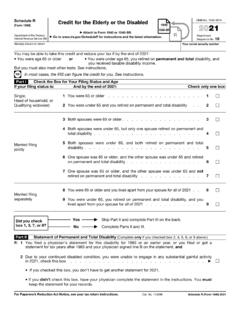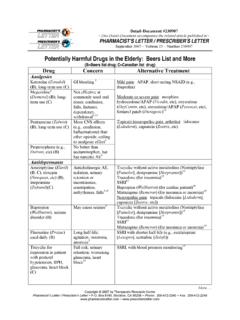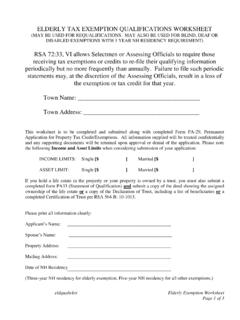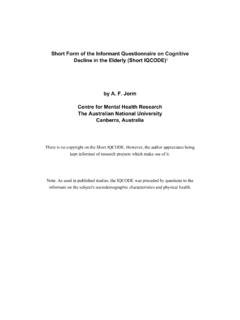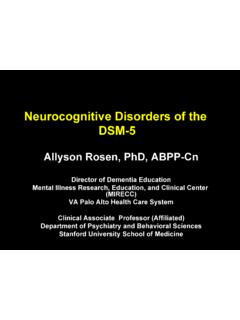Transcription of The Aging and Aging - Centers for Disease Control and ...
1 This report is one in a series from the National Center for Health Statistics, Centers for Disease Control and Prevention. The series of reports on Aging trends was developed with support from the National Institute on Aging and its purpose is to monitor the health of the Aging population. By provid-ing this type of information, we hope to help focus research on the most effective ways to use resources and craft health policy to promote longer, healthier lives. This report presents information on the leading causes of death for older persons in the United States and the recent trends in mortality for this group and is primarily based on data available in the Data Warehouse on Trends in Health and Aging ( ).OverviewSince 1900 life expectancy in the United States has dramatical-ly increased, and the principal causes of death have changed. At the beginning of the 20th century, many Americans died young. Most did not live past the age of 65, their lives often abruptly ended by one of a variety of deadly in-fectious diseases.
2 Over time, death rates dropped at all ages, most dramatically for the young. Today, the vast majority of children born in the United States can expect to live through childhood and into their eighth decade or beyond. About three-fourths of all deaths are among persons ages 65 and older. The majority of deaths are caused by chronic con-ditions such as heart Disease , cancer, stroke, diabetes, and Alzheimer s Disease . During the 20th century these chronic diseases replaced acute infections as the major causes of death. HighlightsBy Yelena Gorina, , ; Donna Hoyert, ; Harold Lentzner, ; and Margie Goulding, AgingTrends series wasdeveloped withsupport from the National Instituteon TrendsNo. 6 October 2005 The leading causes of death among older persons ages 65 years and older are: Heart Disease Cancer Stroke Chronic lower respiratory diseases such as emphysema and chronic bronchitis Infl uenza and pneumonia Alzheimer s Disease Diabetes Nephritis, nephrotic syn- drome, and nephrosis, which are kidney diseases Accidents (unintentional injuries) Septicemia (blood poisoning) Signifi cant trends in mortality among older persons include: Dramatic declines in death rates from heart Disease and stroke Declines in death rates from cancer since 1990 for men and since 2000 for women Increases in Alzheimer s Disease death rates1900 BoysGirls39%43%2002 BoysGirls78%86%Figure 1.
3 Percent of newborns living to age 65: United StatesSOURCE: National Center for Health Healthand AgingTrends in Causes of Death among Older Persons in the United States 2 Trendsin Healthand AgingTrends in Causes of Death among Older Persons in the United States Life expectancy has increased, but will the increase continue?Will we see major advances in life expectancy in the 21st century? Experts disagree. Some say we cannot continue to reduce mortality at the oldest ages without making dramatic and unforeseen medical advances against such major killers as cardiovascular diseases and 3 But others counter that it is not only possible other societies like Japan have already achieved signifi cantly higher life expectancies but likely, as a better educated population increasingly adopt healthier life styles and takes advantage of modern medical 7 What are the leading causes of death for older Americans?
4 Chronic diseases are the leading causes of deathHeart Disease and cancer have been the two leading causes of death for persons 65 years of age and older for the past two decades, account-ing for nearly a million deaths in 2002. Nearly one-third of all deaths among older persons were due to heart Disease , including heart at-tacks and chronic ischemic heart Disease . Cancer accounted for about one-fi fth of all deaths in that age group. The third leading cause of death for older persons is stroke or cerebrovascular Disease , followed by chronic lower respiratory diseases (CLRD), which include chronic bronchitis, emphysema, asthma, and other chronic lower respiratory diseases. The leading causes of death vary among different age, sex, and race and Hispanic origin Fries, JF. Aging , natural death, and the compression of morbidity. N Engl J Med 303(3):130 5. Fries, JF. Strategies for reduction of morbidity. Am J Clin Nutr.
5 55(6 Suppl):1257S 1262S. J, Skrabanek P. Coronary heart Disease is not preventable by population interventions. Lancet 2(8615):839 41. Rothenberg R, Lentzner HR, Parker RA. Population Aging patterns: The expansion of mortality. J Gerontol 46(2):S66 70. KG, Stallard E, Corder L. Changes in morbidity and chronic disability in the elderly population: Evidence from the 1982, 1984, and 1989 National Long Term Care Surveys. J Gerontol B Psychol Sci Soc Sci 50(4): S194 204. KG, Vaupel JW. Survival after the age of 80 in the United States, Sweden, France, England, and Japan. N Engl J Med 333(18):1232 5. EL, Brody JA. Aging , natural death, and the compression of morbidity: Another view. N Engl J Med 309(14):854 6. 1983. Men Women Japan Japan Hong Kong, China France Kong.
6 China Spain Sweden Switzerland Australia Italy Iceland Canada 2. Ten countries with highest life expectancy, 2002 NOTE: Life expectancy in the United States was years for men and years for : Demographic and Social Statistics ( ).
7 NVSR vol. 53, no. 6 ( ).Age-adjustment of death ratesThe death rates presented in this report for the population ages 65 and older are age-adjusted to the standard population in 2000. The age-adjusted rates are calculated using age-spe-cifi c rates for three age groups: 65 74, 75 84, and 85 and older. Age-adjusted rates eliminate differences in observed rates that result from differences in age composition. They are used to compare rates across demographic groups and over Infl uenza and Pneumonia Tuberculosis Diarrhea and Enteritis 31 percent of all deaths2002 Heart Diseases Cancer Stroke 61 percent of all deathsFigure 3. Top three leading causes of death among persons 65 and older in the United StatesSOURCE: Deaths: Leading Causes of 2002. NVSR vol. 53, Healthand AgingTrends in Causes of Death among Older Persons in the United States Figure 4. Leading causes of death for persons ages 65 years and older by sex, 2002 Figure 5.
8 Leading causes of death for persons ages 65 years and older by age, 2002 65 and older 65-74 75-84 85 and older Percent Percent Percent PercentCause of death all deaths Rank all deaths Rank all deaths Rank all deaths RankHeart Disease 1 2 1 1 Cancer 2 1 2 2 Stroke 3 4 3 3 Chronic lower respiratory diseases 4 3 4 6 Infl uenza and pneumonia 5 8 7
9 5 Alzheimer s Disease 6 not in top 10 6 4 Diabetes 7 5 5 7 Nephritis, nephrotic syndrome, and nephrosis 8 7 8 8 Accidents 9 6 9 9 Septicemia 10 9 10 10 Figure 6. Leading causes of death for persons ages 65 years and older by race-Hispanic origin, 2002 Asian or Pacifi c All White Black American Indian Islander Hispanic Percent Percent Percent Percent Percent Percent all all all all all all Cause of death deaths Rank deaths Rank deaths Rank deaths Rank deaths Rank deaths RankHeart Disease 1 1 1 1 1 1 Cancer 2 2 2 2 2 2 Stroke 3 3 3
10 4 3 3 Chronic lower respiratory diseases 4 4 5 5 6 5 Infl uenza and pneumonia 5 6 7 6 5 6 Alzheimer s Disease 6 5 9 9 10 7 Diabetes 7 7 4 3 4 4 Nephritis, nephrotic syndrome, and 8 9 6 8 8 8 nephrosisAccidents 9 8 not in top 10 7 7 9 Septicemia 10 10 8 10 not in top 10 not in top 10 All Male Female Percent Percent PercentCause of death all deaths Rank all deaths Rank all deaths RankHeart Disease 1 1 1 Cancer 2 2 2 Stroke 3 4 3 Chronic lower respiratory diseases 4 3 4 Infl uenza and Pneumonia 5 5 6 Alzheimer s Disease 6 7 5 Diabetes 7 6 7 Nephritis.










